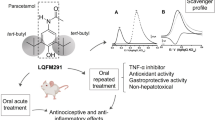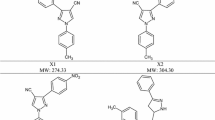Abstract
Ampiroxicam is a nonacidic ether carbonate prodrug of piroxicam. Our results demonstrate that, in contrast to piroxicam, ampiroxicam does not possess detectable prostaglandin synthesis inhibitory activityin vitro. Ampiroxicam, however, has similarin vivo potency to piroxicam in suppressing paw swelling in rat adjuvant arthritis. In an acute model of paw inflammation in rats, ampiroxicam is less potent than piroxicam itself: the ED50's of ampiroxicam are 9- and 3.5-fold higher than those of piroxicam following a single or multiple (5) daily oral doses, respectively. Using the phenylbenzoquinone stretching test as a method of evaluating acute analgetic activity, the ED50 for ampiroxicam is about 3-fold higher than that of piroxicam. These tests of activity share the property of being partially prostaglandin-dependent. Ampiroxicam itself is not observed in plasma after oral dosing to man [24], nor in the rat, dog, and monkey as reported here. Bioavailability studies show that conversion to piroxicam is about 100%, 90%, 70%, and 50% in these four species, respectively. These results indicate that ampiroxicam's anti-inflammatory activity is producedin vivo by conversion to piroxicam and support its credentials as an efficacious prodrug of piroxicam.
Similar content being viewed by others
Abbreviations
- AA:
-
arachidonic acid
- ACN:
-
acetonitrile
- AUC:
-
area under the curve
- C max :
-
maximal achievable plasma concentration of drug
- CO:
-
cyclooxygenase
- DiHETEs:
-
dihydroxyeicosatetraenoic acids
- DMSO:
-
dimethylsulfoxide
- ED50 :
-
dose causing 50% inhibition
- 5-HETE:
-
5-hydroxyeicosatetraenoic acid
- HOAc:
-
acetic acid
- HPLC:
-
high performance liquid chromatography
- IC50 :
-
concentration causing 50% inhibition
- LTB4 :
-
leukotriene B4
- MPE50 :
-
dose which causes 50% of the maximal protective effect achieved with a standard agent
- NSAID:
-
non-steroidal anti-inflammatory drug
- PBQ:
-
phenylbenzoquinone
- PGD2 :
-
prostaglandin D2
- RBL-1:
-
rat basophilic leukemia cell line
- RFE:
-
rat foot edema
- T max :
-
time required to reach maximum drug concentration in plasma
References
J. R. Vane,Inhibition of prostaglandin synthesis as a mechanism of action for aspirin-like drugs. Nature New Biol.231, 232–235 (1971).
R. J. Flower,Drugs which inhibit prostaglandin biosynthesis, Pharmacol. Rev.26, 33–67 (1974).
S. Kumakura, M. Mishima, S. Kobayashi, H. Shirota, S. Abe, K. Yamada and S. Tsurufuji,Inhibitory effect of indomethacin farnesil, a novel anti-inflammatory prodrug, on carrageenin-induced inflammation in rats. Agents and Actions29, 286–291 (1990).
G. Schwenker and J. Chen,1,2-Dihydro-3,1-benzoxazin-4-one and 4H-1, 2-dihydro-pyrido-[2,3-d]-[1,3]-oxazin-4-one derivatives as potential prodrugs. Part I: Synthesis. Arch. Pharm. (Weinheim)324, 821–825 (1991).
R. Shanbhag, A. M. Crider, R. Gokhale, A. Harpalani and R. M. Dick,Ester and amide prodrugs of ibuprofen and naproxen: synthesis, anti-inflammatory activity, and gastrointestinal toxicity. J. Pharmacol. Sci.81, 149–154 (1992).
M. W. Whitehouse and K. D. Rainsford,Esterification of acidic antiinflammatory drugs suppresses their gastrotoxicity without adversely affecting their anti-inflammatory activity in rats. J. Pharm. Pharmacol.32, 795–796 (1980).
H. Bundgaard and N. M. Nielsen,Esters of N,N-disubstituted 2-hydroxyacetamides as a novel highly biolabile prodrug type for carboxylic acid agents. J. Med. Chem.30, 451–454 (1987).
F. J. Persico, J. F. Pritchard, M. C. Fisher, K. Yorgey, S. Wong and J. Carson,Effect of tolmetin glycine amide (McN-4366), a prodrug of tolmetin sodium, on adjuvant arthritis in the rat. J. Pharm. Exp. Ther.247, 889–896 (1988).
N. M. Nielsen and H. Bundgaard,Evaluation of glycolamide esters and various other esters of aspirin as true aspirin prodrugs. J. Med. Chem.32, 727–734 (1989).
G. Chérié-Ligniére, G. Montagnani, M. Alberici and D. Acerbi,Plasma and synovial fluid concentrations of piroxicam during prolonged treatment with piroxicam pivalic ester. Arzneim.-Forsch./Drug Res.37, 560–563 (1987).
G. Chérié-Lignière and F. DeGennaro,Topical use of cinnoxicam. Clinical trials of anti-inflammatory activity. Gazz. Med Ital.-Arc. Sci. Med.149, 223–226 (1990).
Cinnoxicam, piroxicam cinnamate, Drugs of the Future16, 164 (1991).
A. J. Farre, M. Colombo, A. Fort, B. Gutiérrez, L. Rodriguez and R. Roser,Pharmacological properties of droxicam, a new non-steroidal antiinflammatory agent. Med. Find. Exptl. Clin. Pharmacol.8, 407–422 (1986).
J. Esteve, A. J. Farre and R. Roser,Pharmacological profile of droxicam. Gen. Pharmacol.19, 49–54 (1988).
A. Esteve, L. Martinez, R. Roser and R. Sagarra,Pharmacokinetics of droxicam in rat and dog. Meth. Find. Exp. Clin. Pharmacol.8, 423–429 (1986).
J. G. Lombardino,Medicinal chemistry of acidic nonsteroidal antiinflammatory drugs. InNonsteroidal Antiinflammatory Drugs. (Ed. J. G. Lombardino) Chap. 4, pp. 379–386. Wiley, New York 1985.
J. G. Lombardino and E. H. Wiseman,Sudoxicam and related N-heterocyclic carboxamides of 4-hydroxy-2H-1,2-benzothiazine 1,1-dioxide. Potent nonsteroidal antiinflammatory agents. J. Med. Chem.15, 848–849 (1972).
T. J. Carty, J. D. Eskra, J. G. Lombardino and W. W. Hoffman,Piroxicam, a potent inhibitor of prostaglandin production in cell culture. Prostaglandins19, 51–59 (1980).
F. Sakamoto, S. Ikeda and G. Tsukamoto,Studies on prodrugs. II. Preparation and characterization of (5-subsituted 2-oxo-1,3-dioxolen-4-yl) methyl esters of ampicillin. Chem. Pharm. Bull.32, 2241–2248 (1984).
N.-O. Bosdin, B. Ekström, U. Forsgren, L.-P. Jalar, L. Magni, C.-H. Ramsay and B. Sjöberg,Bacampicillin: a new orally well-absorbed derivative of ampicillin. Antimicrob. Agents and Chemother.8, 518–525 (1975).
W. v. Daehne, E. Frederiksen, E. Gundersen, F. Lund, P. Mørch, H. J. Petersen, K. Roholt, L. Tybring and W. O. Godtfredsen,Acyloxymethyl esters of ampicillin. J. Med. Chem.13, 607–612 (1970).
Liposomal flubiprofen axetil. Drugs of the Future17, 788–790 (1992).
A. Marfat, T. J. Carty, J. G. Lombardino, P. F. Moore, T. M. Twomey and A. Weissman,Prodrugs of piroxicam. Proc. Third International Conference of the Inflammation Research Association, White Haven, PA, October, 1986.
F. C. Falkner, T. M. Twomey, A. P. Borger, D. Garg, D. Weidler, N. Gerber and I. W. Browder,Disposition of ampiroxicam, a prodrug of piroxicam, in man. Xenobiotica20, 645–652 (1990).
A. Marfat,Ether prodrugs of antiinflammatory oxicams. U.S. Patent #4551452.
B. A. Jakschik and L. H. Lee,Enzymatic assembly of slow reacting substance. Nature (London)287, 51–52 (1980).
B. A. Jakschik, L. H. Lee, G. Shuffer and C. W. Parker,Arachidonic acid metabolism in rat basophilic leukemia (RBL-1) cells. Prostaglandins16, 733–748 (1978).
B. A. Jakschik, F. F. Sun, L. H. Lee and M. M. Steinhoff,Calcium stimulation of a novel lipoxygenase. Biochem. Biophys. Res. Commun.95, 103–110 (1980).
C. A. Winter, E. A. Risley and G. W. Nuss,Carrageenin-induced edema in hind paw of the rat as an assay for antiinflammatory drugs. Proc. Soc. Exp. Biol. Med.111, 544–547 (1962).
E. Siegmund, R. Cadmus and G. Lu,A method for evaluating both non-narcotic and narcotic analgesics. Proc. Soc. Exp. Biol. Med.95, 729–731 (1957).
G. M. Milne and T. M. Twomey,The analgetic properties of piroxicam in animals and correlation with experimentally determined plasma levels. Agents and Actions10, 31–37 (1980).
D. T. Walz, M. M. Dolan, M. J. DiMartino and S. L. Yankell,Effects of topical hydrocortisone and acetylsalicylic acid on the primary lesion of adjuvant-induced arthritis. Proc. Soc. Exp. Biol. Med.137, 1466–1471 (1971).
T. J. Carty, J. S. Stevens, J. G. Lombardino, M. J. Parry and M. J. Randall,Piroxicam, a structurally novel anti-inflammatory compound. Mode of prostaglandin synthesis inhibition. Prostaglandins19, 671–682 (1980).
F. J. Sweeney, J. D. Eskra, M. J. Ernest and T. J. Carty,Spectrophotometric monitoring of lipoxygenase and cyclo-oxygenase pathway activity using ionophore stimulated whole blood. Agents and Actions21, 393–396 (1987).
I. G. Otterness and M. L. Bliven,Laboratory models for testing nonsteroidal antiinflammatory drugs. InNonsteroidal Antiinflammatory Drugs. (Ed. J. G. Lombardino), Chap. 3, pp. 119, 147, 172. Wiley, New York 1985.
A. Swahn,Gastrointestinal absorption and metabolism of two 35 S-labelled ampicillin esters. Eur. J. Clin. Pharmacol.9, 299–306 (1976).
Author information
Authors and Affiliations
Rights and permissions
About this article
Cite this article
Carty, T.J., Marfat, A., Moore, P.F. et al. Ampiroxicam, an anti-inflammatory agent which is a prodrug of piroxicam. Agents and Actions 39, 157–165 (1993). https://doi.org/10.1007/BF01998969
Received:
Accepted:
Issue Date:
DOI: https://doi.org/10.1007/BF01998969




